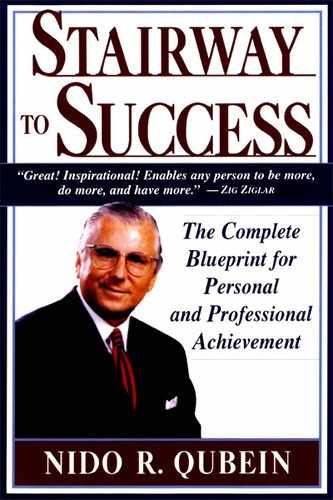PRELUDE TO STEP FOUR
READY, SET, GO!
For all your days, prepare,
And meet them ever alike;
When you are the anvil, bear;
When you are the hammer, strike.—EDWIN MARKHAM
A good plan takes you nowhere. It only tells you where you expect to go. Tracing your route on a road map doesn’t get you from Topeka to Los Angeles. Getting there requires that you hit the road. But before you hit the road, there are preparations to make. You have to pack your bags, make sure your vehicle is in good condition, fill your gas tank, and stock up on travelers’ checks.
Action usually comes at the end of a series of preparatory steps, best described in the starter’s words at the beginning of a race: Get ready, Get set, GO!
At the “Get ready” signal, foot racers assume a balanced stance that allows them to respond quickly when the action signal is given. Successful people acquire balance, too, in the physical, mental/emotional, social, and spiritual aspects of their lives. When you achieve this state of equilibrium, you’re ready to accept any challenge and conquer any barrier between you and success.
Acquiring balance means achieving that happy medium between minimum and maximum that represents your optimum. The minimum is the least you can get by with. The maximum is the most you’re capable of. The optimum is the amount or degree of anything that is most favorable toward the ends you desire.
Let me illustrate the difference between maximum and optimum. Your automobile may be capable of a maximum speed of more than one hundred miles per hour, but if your objective is reliable, safe, and comfortable transportation, you’ll never drive it at top speed. At a hundred miles per hour, you’re subjecting it to excessive wear and the likelihood of a fatal crash.
At the other extreme, your car can crawl along at five to ten miles per hour, minimizing the chances of your losing control on a curve or crashing head-on into an object or rear-ending the vehicle ahead. But at such speeds your car is an inefficient form of transportation. It’s wasting time and horsepower, and if other traffic is traveling at normal freeway speeds, it poses safety hazards.
Your car’s optimum speed is a steady pace somewhere between those high and low speeds—probably between fifty-five and sixty-five miles per hour on an interstate highway. That speed range usually provides the best combination of safety. fuel mileage. engine wear, and travel time.
To use a human illustration, if you’re running the marathon and you go all-out for the first mile, you may take an early lead, but the victory will go to the runner who strikes the highest sustainable pace. If the pace is too slow, the others will pass you. If it’s too fast, you’ll run out of energy before you reach the end of the race. You have to choose a happy medium. You need to strike the same kind of balance in your personal habits and behavior.
“Getting set” entails bringing yourself to a motivational edge that allows you to put your heart and soul into the effort once the action has begun. Acquiring motivation means developing a strong reason to carry your action plan to a successful conclusion.
When you’re balanced and motivated, you’re ready to respond to the signal, “GO!—
